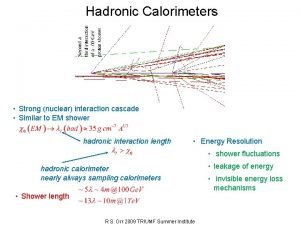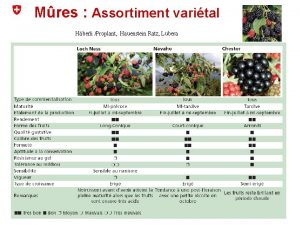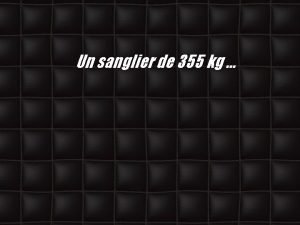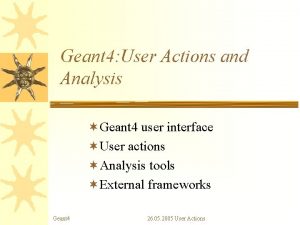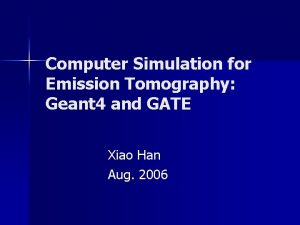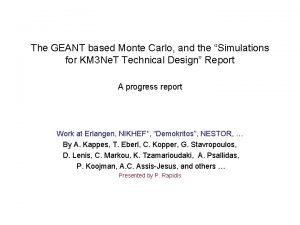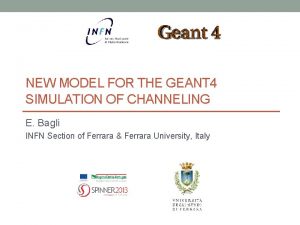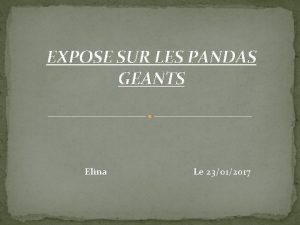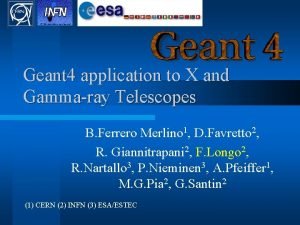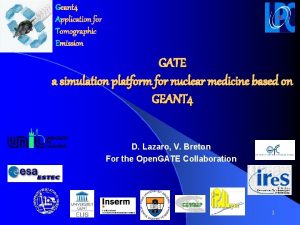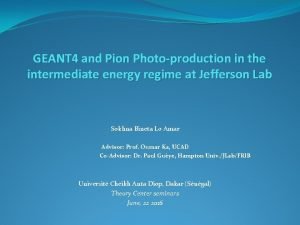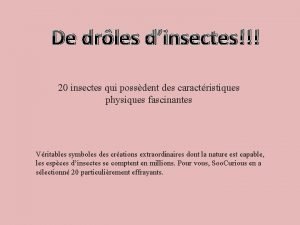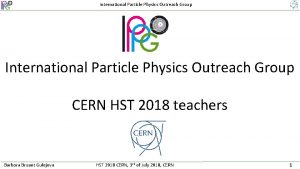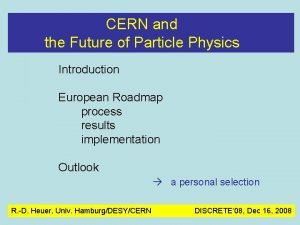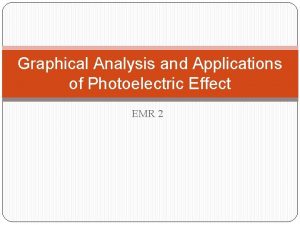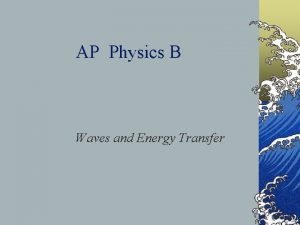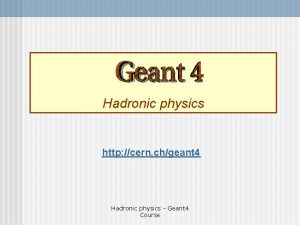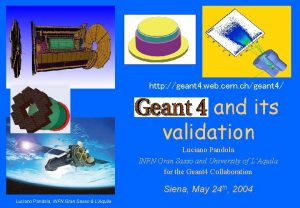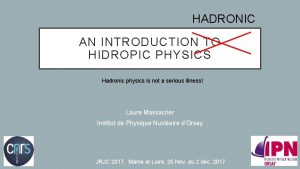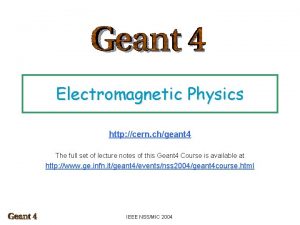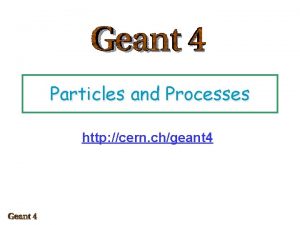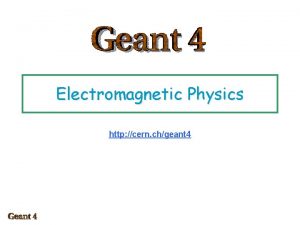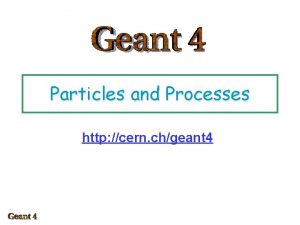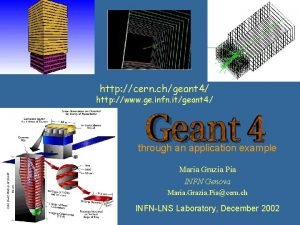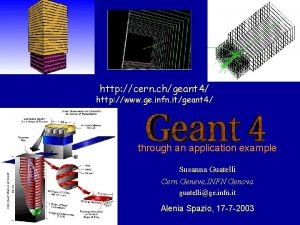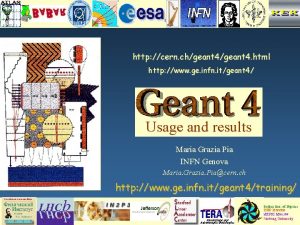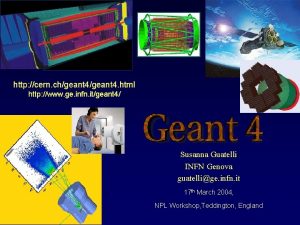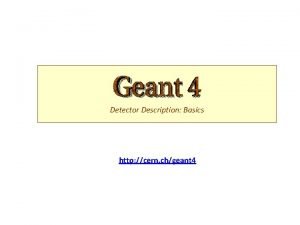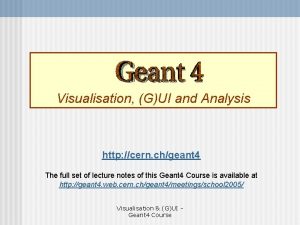Geant 4 Hadronic Physics http cern chgeant 4

































- Slides: 33

Geant 4 Hadronic Physics http: //cern. ch/geant 4 1

Acnowledgements • These slides are based on Dennis Wright Aatos Helkkinen IEEE 2003 and IEEE 2004 Geant 4 lecture notes 2

Outline • • Processes and hadronic physics Hadronic cross sections Parametrised models Theoretical models Model framework Physics lists Code examples Physics validation against experimental data 3

Hadronic physics challenge • Even though there is an underlying theory (QCD), applying it is much more difficult than applying QED for simulating electromagnetic interactions • We must deal with at least three energy régimes: – Chiral perturbation theory (< 100 Me. V) – Resonance and cascade region (100 Me. V – 20 Ge. V) – QCD strings (> 20 Ge. V) • Within each regime there are several models: – Many of these are phenomenological 4

The Geant 4 philosophy of hadronics (1/2) • Provide a general model framework that allows implementation of processes and models at many levels • Separate models and processes in framework: – Hadronic models and cross sections implement processes • Provide processes containing: – Many possible models and cross sections – Default cross sections for each model 5

The Geant 4 philosophy of hadronics (2/2) • Provide several optional models and cross section sets in each region • Let the user decide which physics is best: – Complex task is handled with physics lists – Educated guess physics lists are provided by use-case • Validate new models against latest data: – Extensive and systematic validation program 6

Geant 4 process • A process uses cross sections to decide when and where an interaction will occur: – Get. Physical. Interaction. Length() • A process uses an interaction model to generate the final state: – Do. It() • Three types of process: – At. Rest – Along. Step – Post. Step • Each particle has its own process manager • Each process has a set of models coordinated with energy range manager 7

Hadronic process • At rest: – Stopped muon, pion, kaon, anti-proton – Radioactive decay • Elastic: – Same process for all long-lived hadrons • Inelastic: – Different process for each hadron – Photo-nuclear – Electro-nuclear • Capture: – Pion- and kaon- in flight • Fission 8

Cross sections • Default cross section sets are provided for each type of hadronic process: – Fission, capture, elastic, inelastic – Can be overridden or completely replaced • Different types of cross section sets: – Some contain only a few numbers to parameterize cross section – Some represent large databases (data driven models) • Cross Section Management: – Get. Cross. Section() sees last set loaded for energy range 9

Alternative cross sections • Low energy neutrons – G 4 NDL available as Geant 4 distribution data files – Available with or without thermal cross sections • Neutron and proton reaction cross sections – 20 Me. V < E < 20 Ge. V • Ion-nucleus reaction cross sections – Good for E/A < 1 Ge. V • Isotope production data – E < 100 Me. V 10

Different types of hadronic shower models • Data driven models • Parametrisation driven models • Theory driven models 11

Models in hadronic framework 12

Data driven models (1/2) • Characterized by lots of data: – Cross section – Angular distribution – Multiplicity • To get interaction length and final state, models simply interpolate data: – Usually linear interpolation of cross section, and Legendre polynomials • Examples: – Coherent elastic scattering (pp, nn) – Radioactive decay – Neutrons (E < 20 Me. V) 13

Data driven models (2/2) • Transport of low energy neutrons in matter: – The energy coverage of these models is from thermal energies to 20 Me. V – The modeling is based on the data formats of ENDF/B-VI, and all distributions of this standard data format are implemented – The data sets used are selected from data libraries that conform to these standard formats – The file system is used in order to allow granular access to, and flexibility in, the use of the cross-sections for different isotopes, and channels – Code in sub-directory: /source/processes/hadronic/models/neutron_hp 14

Parametrisation driven models (1/2) • Depends on both data and theory: – Enough data to parameterize cross sections, multiplicities, angular distributions • Final states determined by theory, sampling: – Use conservation laws to get charge, energy, etc. • Examples: – Fission – Capture – LEP, GEISHA based HEP models 15

Parametrisation driven models (2/2) • Based on GHEISHA package of Geant 3. 21, two sets of models exist for inelastic scattering of particles in flight: – Low energy models: • E < 20 Ge. V • /hadronic/models/low_energy – High energy models: • 20 Ge. V < E < O(Te. V) • /hadronic/models/high_energy • Original approach to primary interaction, nuclear excitation, intra-nuclear cascade and evaporation is kept • Fission, capture and coherent elastic scattering are also modeled through parametrised models 16

Theory driven models (1/2) • Dominated by theory (QCD, strings, chiral perturbation theory) • Data used mainly for normalization and validation • Final states determined by sampling theoretical distributions • Philosophy implies the usage physics lists, providing wanted collection of models, such as: – Parton string models at high energies, of intra-nuclear transport models at intermediate energies, and of statistical break-up models for de-excitation 17

Theory driven models (2/2) • Parton string: – Projectiles with E > 5 Ge. V – /hadronic/models/parton_string • Chiral invariant phase space, CHIPS: – All energies – Quark-level event generator for the fragmentation of hadronic systems into hadrons – Interactions between hadrons are treated as purely kinematic effects of quark exchange – Decay of excited hadronic systems is treated as the fusion of two quark-partons within the system – Includes nonrelativistic phase space of nucleons to explain evaporation – /hadronic/models/chiral_inv_phase_space • Nuclear de-excitation and breakup 18

Bertini intra-nuclear cascade (1/2) • Collection of theory driven models with parametrisation features: – /hadronic/models/cascade • Intermediate energies ~100 ke. V – 10 Me. V • Models included: – – – Bertini INC model with exitons Pre-equilibrium model Nucleus explosion model Fission model Evaporation model 19

Bertini intra-nuclear cascade (2/2) • For A>4 a nuclei model is composed of three concentric spheres • Impulse distribution in each region follows Fermi distribution with zero temperature • Particle treated p, n, pions, photon evaporation and nuclear isotope remnats • Latest addition include incident kaons up to an energy of 15 Ge. V: – Final states, will be included for K+, K-, K 0 bar, lambda, sigma+, sigma 0, sigma-, xi 0 and xi- Schematic presentation of the intranuclear cascade. A hadron with 400 Me. V energy is forming an INC history. Crosses present the Pauli exclusion principle in action. 20

Hadronic model inventory 21

Physics Lists – putting physics into your simulation • User must implement a physics list: – – – Derive a class from G 4 VUser. Physics. List Define the particles required Register models and cross sections with processes Register processes with particles Set secondary production cuts In main(), register your physics list with the Run Manager • Care is required: – Multiple models, cross sections allowed per process – No single model covers all energies, or all particles – Choice of model is heavily dependent on physics studied 22

Physics lists by use case • Geant 4 recommendation: – Use example physics lists – Go to Geant 4 home page > Site Index > physics lists • Many hadronic physics lists available including: – – Low and high energy nucleon penetration shielding Low energy dosimetric applications Medical neutron applications Low background experiments (underground) 23

Code Example (1/2) void My. Physics. List: : Construct. Proton() { G 4 Particle. Definition* proton = G 4 Proton: : Proton. Definition(); G 4 Process. Manager* proton. Process. Manager = proton>Get. Process. Manager(); // Elastic scattering G 4 Hadron. Elastic. Process* proton. Elastic. Process = new G 4 Hadron. Elastic. Process(); G 4 LElastic* proton. Elastic. Model = new G 4 LElastic(); proton. Elastic. Process->Register. Me(proton. Elastic. Model); proton. Process. Manager>Add. Discrete. Process(proton. Elastic. Process); 24

Code example (2/2) . . . // Inelastic scattering G 4 Proton. Inelastic. Process* proton. Inelastic. Process = new G 4 Proton. Inelastic. Process(); G 4 LEProton. Inelastic* proton. Low. Energy. Inelastic. Model = new G 4 LEProton. Inelastic(); proton. Low. Energy. Inelastic. Model>Set. Max. Energy(20. 0*Ge. V); proton. Inelastic. Process>Register. Me(proton. Low. Energy. Inelastic. Model); G 4 HEProton. Inelastic*proton. High. Energy. Inelastic. Model = new G 4 HEProton. Inelastic(); proton. High. Energy. Inelastic. Model- 25

Gean 3. 21 based Geant 4 LEP model pion production from 730 Me. V proton on Carbon 26

Bertini cascade model pion production from 730 Me. V proton on Carbon 27

Bertini cascade model nuclei fragmet production from 170 Me. V proton on Uranium 28

Double differential cross-section for neutrons produced by 256 Me. V protons. 29

Comparison of differential pion yields for positive and negative pions in pion Magnesium reactions at 320 Ge. V lab momentum. The dots are data and the open circles are Monte Carlo predictions by G 4 QGSModel. 30

Geant 4 simulation of gammas from 14 Me. V neutron capture on uranium. 31

32

Conclusion • Geant 4 provides a large number of hadronic physics models for use in simulation • Cross sections, either calculated or from databases, are available to be assigned to processes • Interactions are implemented by models which are then assigned to processes. • For hadrons there are many models to choose from, so physics lists are provided by use-case 33
 Hadronic
Hadronic Hadronic shower
Hadronic shower Myrtillier géant
Myrtillier géant Geant network map
Geant network map Sanglier turquie record
Sanglier turquie record Engin de chantier le plus gros du monde
Engin de chantier le plus gros du monde Action geant
Action geant Geant computer
Geant computer Geant simulation
Geant simulation Geant 4
Geant 4 Géant atlas pointure
Géant atlas pointure Exposé sur les pandas
Exposé sur les pandas Geant 4
Geant 4 Niconical
Niconical Pub geant
Pub geant Gate geant
Gate geant Pion geant
Pion geant Chenille brahmin
Chenille brahmin Cern particle physics
Cern particle physics Cern particle physics
Cern particle physics Http //mbs.meb.gov.tr/ http //www.alantercihleri.com
Http //mbs.meb.gov.tr/ http //www.alantercihleri.com Siat.ung.ac.id krs
Siat.ung.ac.id krs Kcvs.ca
Kcvs.ca Http://www.colorado.edu/physics/phet
Http://www.colorado.edu/physics/phet Modern physics vs classical physics
Modern physics vs classical physics University physics with modern physics fifteenth edition
University physics with modern physics fifteenth edition Ib physics ia example
Ib physics ia example Ycc cern
Ycc cern Ski club cern
Ski club cern Cern service now
Cern service now Cern reception building 33
Cern reception building 33 Cern staff association
Cern staff association Cern goods reception
Cern goods reception Cern users office
Cern users office

